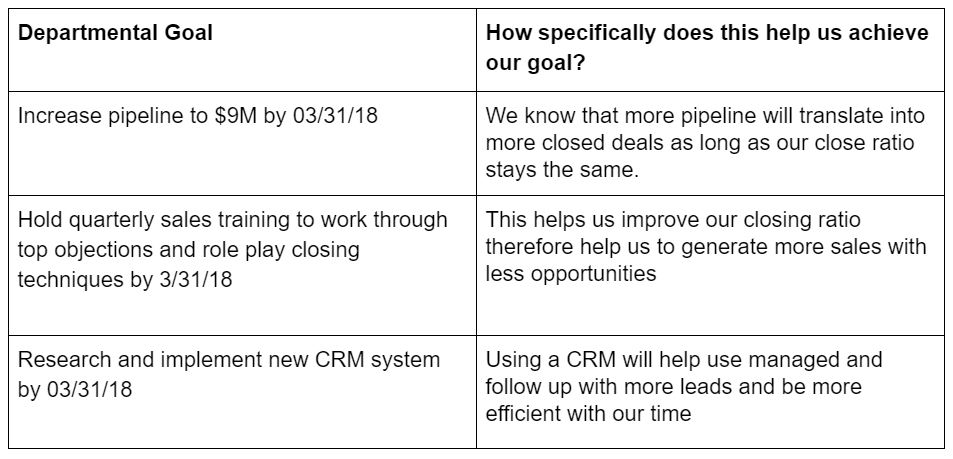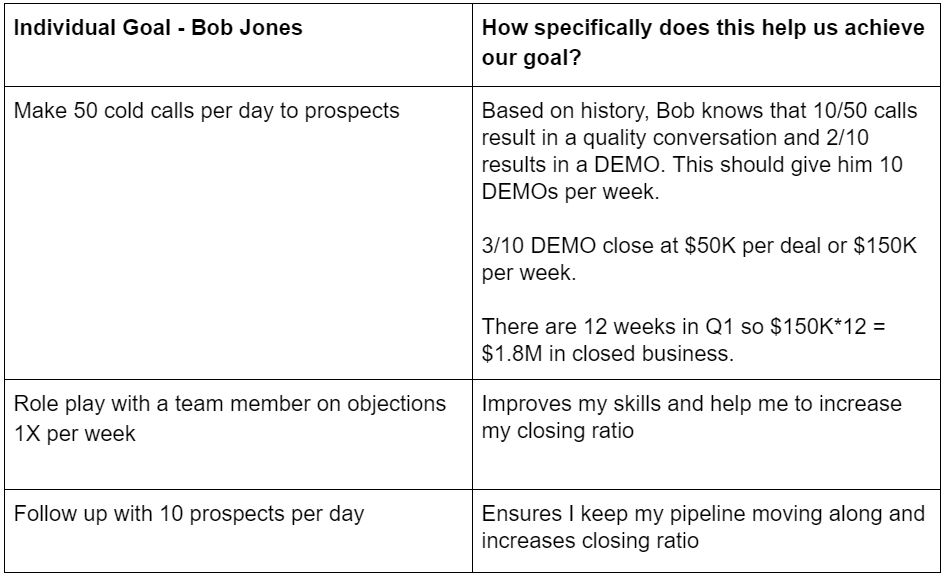Company goals are ineffective when those goals remain trapped in the minds of leadership – even worse when they stay trapped in the mind of one person.
When this happens, the rest of the team is left to guess what is most important.
In order to operationalize a company’s goals, those goals must cascade down throughout the organization. Each team member must translate those goals into monthly, weekly, and daily actions.
Makes sense right, but exactly how do you do that?
This blog post is meant to offer a step-by-step process for cascading company goals down to departmental goals, then further down to individual goals.
Step 1 – Start With 100% Clarity Around A Company Goal
Cascading goals throughout the organization will not work if there is no clarity at the top. If you’re not 100% sure that clarity exists, check out this blog post for a step by step process to define and clarify your company goals. Another way to confirm this is to ask your team. Have them tell you what they think the company is focused on this quarter. You may be surprised by the results.
This is not just my opinion, Locke et al. (1981) and Donovan (2001) explained that effective goal setting drives employee motivation and better performance. When goals are specified employees know what to prioritize which leads to improved outcomes.
We’ll assume that the clarity exists and that you’ve defined the top-level company goals.
For example, let’s take the following company goal:
“ John, VP of Sales will Increase top-line revenue to $12M by 12/31/18″
You can see that this goal is SMART.
- Specific – It is specific with a clearly defined objective.
- Measurable – We attach a KPI (key performance indicator) to the goal so we know when it’s been achieved, in this case “revenue”.
- Attainable / Assignable – John, Vp of Sales is responsible for achieving this goal.
- Relevant – Is this aligned with our overall strategy? The answer to this question is not easily answerable from the goal, but it’s an important question to ask.
- Time-Bound – It is due by 12/31/18.
The main point being, there cannot be any ambiguity around the company goal. It needs to be specific (no question regarding what needs to be accomplished). It needs a clear owner (in this case John – VP of sales). It needs to be measurable – $12M in sales. You get the point.
The team will fail to execute if the goal is not clear. So, take your time and get this part right. Create a set of goals with your team and make sure everyone understands what is expected.
If you need help developing your company goals in the first place, we’ve created a simple guide which you can access below:
Free Company Goal Setting Guide
Step 2 – Break Each Company Goal Into Departmental (Functional) Goals Or Initiatives
The next step is to determine what needs to happen in order to achieve this top-level goal.
Typically, company goals are segmented by department or functional area (i.e. sales, marketing, production, finance, etc). You can also use the balanced scorecard approach which we talk about here. The owner of each company goal often leads a department or main function of the business. In the case of the balanced scorecard, that is finance, customer, internal processes, and learning and growth. There can be some overlap here, but the point is that the responsibility for the companies success is not on one individual’s shoulders, everyone must work together.
Taking our example from earlier, the department, in this case, is “Sales”.
The sales department needs to now determine how it will achieve the company goal of $12M in revenue. What is the plan?
My suggestion is to meet as a team and brainstorm a number of milestones (I call them initiatives), which if achieved, would help guarantee the achievement of the company goal. Meeting as a team ensures buy-in and gives you the best chance of winning.
To test the alignment with the company goal, ask the question, “how does this plan help us achieve our goal”?
Once you’ve developed a list of initiatives (milestones), prioritize them in terms of impact on the company goal.
For example:

This process forces the team to vet and develop a plan which is transparent and can be vetted by other members of the team. It might make sense to share this overall plan with the rest of the management team and get their feedback. Again the goal is that the entire team “wins”. Getting other management team members in on the process ensures any holes in the plan will be identified.
Finally, ask the question, “how confident are we that these departmental goals/initiatives will help us achieve the company goal”? If you find that your confidence is low, go back to the drawing board and develop a stronger plan.
Step 3 – Break Each Departmental Goal / Initiative Into Individual Goals / Initiatives
Now that you’ve broken the company goal into the main milestones (departmental initiatives) that are necessary to achieve the company goal, each of those department initiatives needs to be further broken down into individual initiatives or goals.
Take the same approach as you did with the departmental goals. Challenge each member of the team to pick a departmental goal to align their individual goal with.
Let’s pick the goal – “Increase pipeline to $9M by 03/31/18”
Bob Jones, who is one of the account executives may only have a percentage of that goal to achieve. In this example, it’s $1.8M.
Bob could then break his goal down into weekly activities which will help him achieve his goal. His goals might be:

It will take some thinking and brainstorming in order to truly operationalize each company goal. This takes time, but the payoff is huge if executed correctly.
In the process, you may find that your company goal is not as realistic as you thought. You want the people actually doing the work to be 100% bought-in and engaged during the goal-setting process or the company goals are doomed to fail.
I hope this post has helped connect the dots for you on how to translate a company goal to a departmental goal, and then finally to an individual goal.
If you need help, or just have a question, feel free to contact us.
References
Locke, E. A., Shaw, K.N., Saari, L. M., and, G. P. (1981). Goal setting and task performance. Psychological Bulletin, 90(1), pp.125-152.
Donovan, J. J. (2001). Work motivation. In Anderson, N., Ones, D.S., Sinangil, H. K., and Viswesvaran, C. (Eds.), Handbook of Industrial, Work, and
Organizational Psychology (pp. 53-76). London: Sage Publications.
